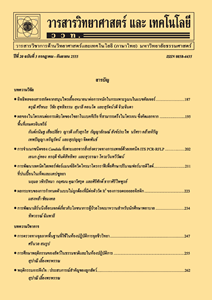การเปลี่ยนแปลงของสารอินทรีย์และธาตุอาหารในดินตะกอนป่าชายเลนที่มีแสมขาวเป็นพันธุ์ไม้เด่น
Main Article Content
Abstract
บทคัดย่อ
ศึกษาเรื่องการเปลี่ยนแปลงของสารอินทรีย์และธาตุอาหารในดินตะกอนป่าชายเลนที่มีแสมขาวเป็นพันธุ์ไม้เด่นที่ศูนย์ศึกษาธรรมชาติและอนุรักษ์ป่าชายเลนเพื่อการท่องเที่ยวเชิงนิเวศ จังหวัดชลบุรี โดยการวางแปลงตัวอย่างจำนวน 3แปลง ขนาด 50×50 เมตร ที่มีคุณลักษณะพื้นฐานของหมู่ไม้ที่แตกต่างกัน คือ ไม้ใหญ่ (แปลงตัวอย่าง A) ไม้ขนาดกลาง (แปลงตัวอย่าง B) และไม้รุ่น (แปลงตัวอย่าง C) ตลอดระยะเวลาการศึกษาตั้งแต่เดือนเมษายน พ.ศ.2551 ถึงเดือนธันวาคม พ.ศ.2551 พบว่าปริมาณน้ำในดินตะกอนมีค่าอยู่ระหว่างร้อยละ 35.59-74.72 ปริมาณสารอินทรีย์รวมในดินตะกอนมีค่ายู่ระหว่างร้อยละ 3.27-14.62 ปริมาณไนโตรเจนรวมมีค่าอยู่ระหว่างร้อยละ 0.14-0.89 และปริมาณฟอสฟอรัสรวมในดินตะกอนมีค่าอยู่ระหว่างร้อยละ 0.03-0.11 ดัชนีคุณภาพดินตะกอนแต่ละดัชนีมีค่าสูงที่สุดในแปลงตัวอย่าง A และต่ำที่สุดในแปลงตัวอย่าง C โดยที่อิทธิพลของฤดูกาลมีผลต่อความผันแปรของคุณภาพดินตะกอนชัดเจนนักเมื่อเทียบกับคุณลักษณะพื้นฐานของหมู่ไม้ เมื่อพิจารณาถึงคุณภาพน้ำในดินตะกอน เช่น ปริมาณไนไตรท์-ไนโตรเจนมีค่าอยู่ระหว่าง 0.001-0.077 มิลลิกรัมต่อลิตร ปริมาณไนเตรท-ไนโตรเจนมีค่าอยู่ระหว่าง 0.000-0.124 มิลลิกรัมต่อลิตร ปริมาณแอมโมเนีย-ไนโตรเจนมีค่าอยู่ระหว่าง 0.007-0.756 มิลลิกรัมต่อลิตร ปริมาณฟอสเฟต-ฟอสฟอรัสมีค่าอยู่ระหว่าง 0.107-2.656 มิลลิกรัมต่อลิตร และปริมาณไฮโดรเจนซัลไฟด์มีค่าอยู่ระหว่าง 6.06-68.14 มิลลิกรัมต่อลิตร คุณภาพน้ำในดินตะกอนมีความแตกต่างกันอย่างมีนัยสำคัญทางสถิติที่ระดับความเชื่อมั่นร้อยละ 95 ตามฤดูกาลและคุณลักษณะพื้นฐานของหมู่ไม้ การศึกษาครั้งนี้แสดงให้เห็นว่า คุณลักษณะพื้นฐานของหมู่ไม้ของไม้แสมขาวส่งผลต่อคุณภาพและธาตุอาหารในดินตะกอน โดยที่หมู่ไม้ขนาดใหญ่และอายุมาก จะส่งผลต่อการสะสมตัวของสารอินทรีย์ในดินตะกอนได้ดีกว่าหมู่ไม้ขนาดเล็กหรือไม้ที่มีอายุน้อย
คำสำคัญ : ป่าชายเลน; ปริมาณสารอินทรีย์รวม; ดินตะกอน; ปริมาณน้ำในดินตะกอน; ธาตุอาหาร
AbstractSpatial and temporal variation of organic matter and nutrient in mangrove sediments dominated by Avicennia alba Bl. was investigated in Mangrove conservation and nature education center at Chonburi Province, Thailand. Three permanent plots of 50×50 m were constructed based on the physiognomic characteristics of trees in the area which could be clarified as old stand plot (A), mature plot (B) and young plant plot (C). Mangrove sediment and porewater were retrieved and measured from three occasions during the study period from April until December 2008 in order to find out the influence of Avicennia stands on estuarine. Water contents in sediment were falling in the range from 35.59 to 74.72 %, organic matter contents varied from 3.27 to 14.62 %, total nitrogen fell between 0.14 and 0.89 % and total phosphorus was recorded within the range 0.03-0.11 %. Highest amounts of measured sediment quality parameters were recorded from plot A whereas plot C contained the lowest. Seasonal variation of sediment quality was less pronounced compared to the influence of plant stands. Pore water parameters consisting of NO2-, NO3-, NH4+ and PO43- were examined and exhibited the value between 0.000-0.124 mg/l, 0.001-0.077 mg/l, 0.007-0.756 mg/l and 0.107-2.656 mg/l, respectively. Sulfide was found between 6.06-68.14 mg/l. There was a significant difference (p < 0.05) between plant stands and pore water qualities as well as seasonal variation. These results indicated that plant characteristics were potentially influencing sedimentary properties via the accumulation of organic matter where old stands rather accumulated higher quantity of organic material to sediment underneath than those younger plants.
Keyword: mangrove forest; total organic matter; sediments; water content; nutrient


